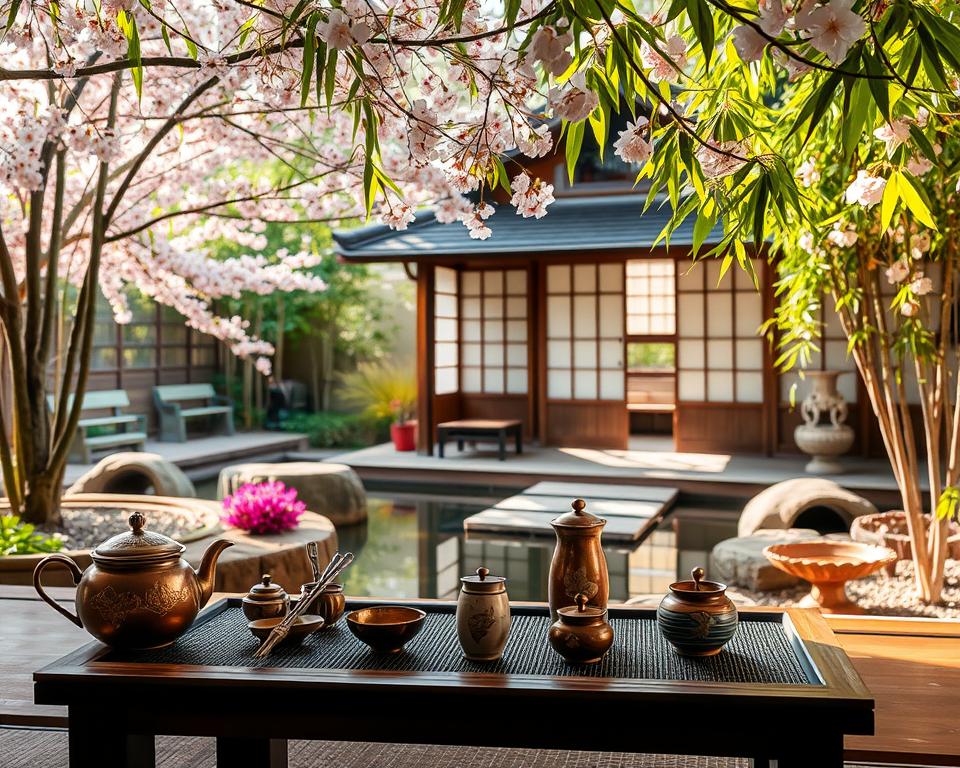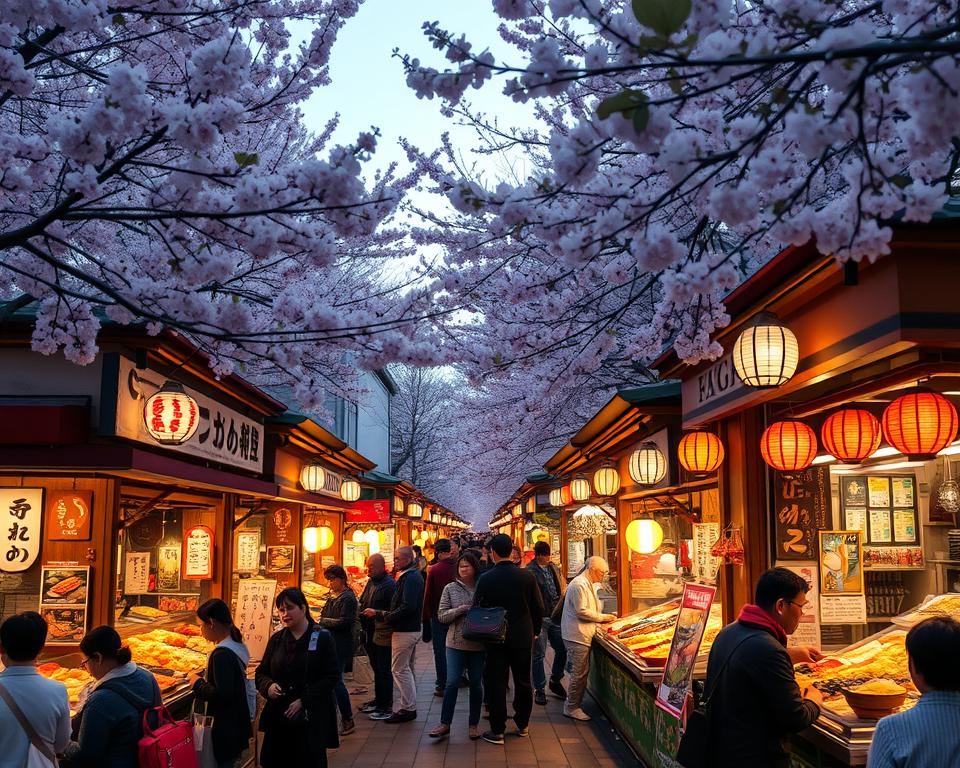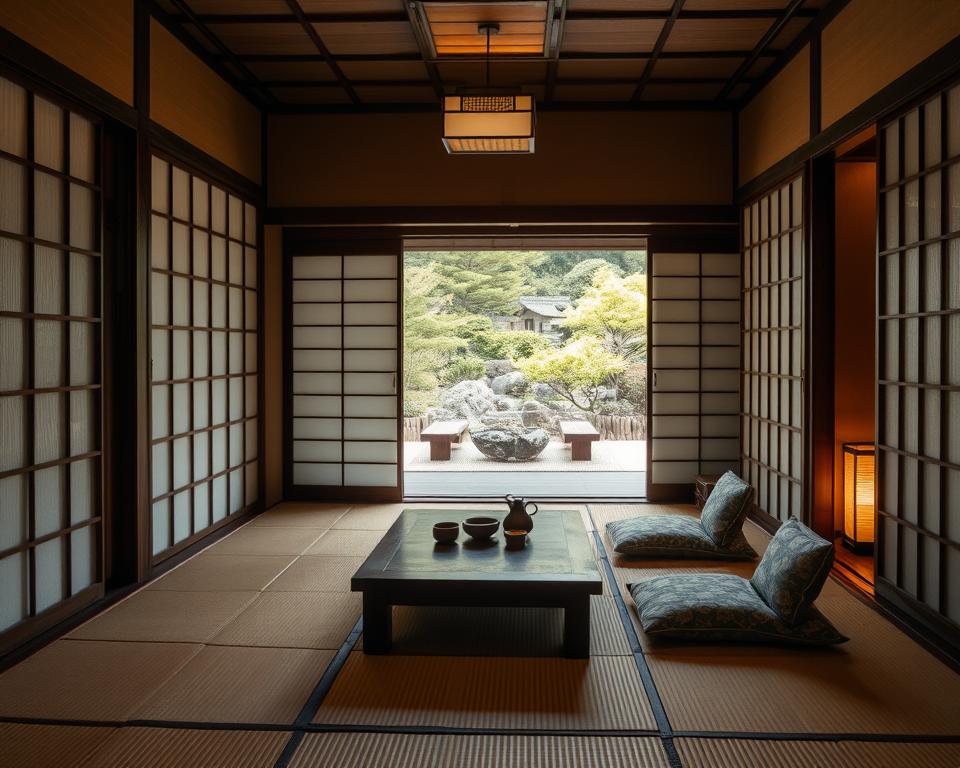15 Essential Cultural Experiences in Japan

Travel to Japan and discover a unique blend of traditional and modern elements. This makes cultural experiences in Japan truly unforgettable. From vibrant cities to serene landscapes, Japan offers a diverse range of experiences. These showcase its rich heritage and innovative spirit.
Cultural experiences in Japan are not just about observing traditions. They are about immersing oneself in the daily life and customs of the Japanese people. Whether you’re interested in Japanese traditions, food, art, or entertainment, there’s something for everyone in this fascinating country.

For travelers seeking an authentic immersion in Japan, exploring various cultural experiences is essential. Japanese traditions, such as the tea ceremony, calligraphy, and martial arts, are an integral part of the country’s heritage. At the same time, modern pop culture, including anime, manga, and video games, has become a significant aspect of Japanese identity.
By experiencing these different facets of Japanese culture, visitors can gain a deeper understanding of the country and its people.
Key Takeaways
- Japan offers a unique blend of traditional and modern cultural experiences
- Cultural experiences in Japan include traditional arts, food, and entertainment
- Travel to Japan provides an opportunity to immerse oneself in Japanese traditions and daily life
- Japanese traditions, such as the tea ceremony and calligraphy, are an integral part of the country’s heritage
- Modern pop culture, including anime and manga, is a significant aspect of Japanese identity
- Cultural experiences in Japan can help visitors gain a deeper understanding of the country and its people
Understanding Japanese Cultural Experiences: An Overview
Japanese culture is all about keeping traditions alive while moving forward. This mix of old and new is seen everywhere, from buildings to art. Events like the Cherry Blossom Festival highlight Japan’s rich history.
Japan works hard to save its history, arts, and customs. This effort creates a special mix of old and new. Visitors can see this by joining in on events like Golden Week, which shows off Japan’s lively culture.
- New Year (Oshogatsu) for traditional festivities
- Spring (March to May) for Cherry Blossom viewing
- Summer (June to August) for festivals and outdoor events
These times give a peek into Japan’s deep cultural roots. You’ll see both old and new together.
By learning about and respecting Japan’s culture, visitors can truly appreciate its unique mix. This makes their trip more meaningful and unforgettable.
| Season | Cultural Events |
|---|---|
| Spring | Cherry Blossom Festival, Golden Week |
| Summer | Festivals, outdoor events |
| Autumn | Autumn foliage, harvest festivals |
Traditional Tea Ceremony: Mastering the Art of Chado
The Japanese tea ceremony, or chado, is a ritual that shows harmony, respect, and calm. It’s a big part of Japanese culture, more than just drinking tea. It celebrates nature, mindfulness, and connecting with others.
In a traditional tea house, the setting is peaceful and close. The host and guests follow a set ritual, using special tools. It’s about enjoying the moment and the beauty of simplicity. Visitors can learn about chado and feel its calm at a traditional tea house.
Some key parts of the Japanese tea ceremony include:
- The preparation and serving of matcha, a special green tea
- The use of traditional Japanese utensils, such as the tea scoop and tea whisk
- The importance of etiquette and mindfulness in the ceremony
- The role of nature and the seasons in the ceremony
The Japanese tea ceremony is a special experience. It lets visitors see traditional Japanese culture and values. By joining a ceremony, you learn about mindfulness, respect, and harmony, and enjoy its beauty.
Embracing Zen in Japanese Gardens and Temples
Japanese Zen gardens and Buddhist temples are peaceful spots that show Japan’s spiritual and artistic side. These calm places let visitors feel Japan’s culture and connect with nature. By visiting, people can learn more about Zen and its impact on Japanese gardens and temples.
It’s important to respect local customs when visiting Japanese Zen gardens and temples. This means dressing modestly, removing shoes before entering temples, and being careful with your actions. Meditation retreats are also an option, letting people dive deep into Zen and practice mindfulness in a calm setting.
Places like the Kenrokuen Garden and the Kairakuen Garden in Japan are must-sees for Zen garden fans. These gardens are designed to show harmony and balance, reflecting Zen’s love for simplicity and nature. Visitors can walk through, enjoying the calm and seeing the gardens’ special features. Meditation experiences, from short sessions to longer retreats, are also available, helping people find inner peace.
By embracing Zen and visiting Japanese Zen gardens and temples, visitors can understand Japan’s culture better. Whether through meditation or just exploring, people can feel Japan’s natural beauty and spiritual essence. This makes for a memorable experience.
Culinary Adventures in Japanese Cuisine
Japanese food culture is a big part of Japan’s identity. It focuses on seasonality, presentation, and flavor balance. Traditional dishes like kaiseki ryori offer a unique experience. This multi-course meal shows Japan’s commitment to quality and simplicity.
Culinary tourism in Japan is on the rise. Many visitors want to dive into the country’s food scene. You can visit local markets, take cooking classes, or try izakayas for a lively food experience.
Some popular dishes include:
- Sushi: a classic dish made with vinegared rice and fresh seafood
- Ramen: a hearty noodle soup made with rich broth and various toppings
- Tempura: a dish made with lightly battered and fried seafood and vegetables
Japanese food culture is more than just food. It’s about social interactions and celebrations. Mealtimes are for bonding with family and friends. Traditional dishes are often served at special occasions like weddings and holidays.
For those interested in culinary tourism in Japan, there are many resources. You can find cooking classes, food tours, and restaurant guides. Japanese cuisine offers a mix of traditional and modern flavors for every palate.

Whether you’re a foodie, traveler, or cooking enthusiast, Japanese cuisine will impress you. It’s all about quality, simplicity, and tradition. Traditional Japanese dishes truly reflect Japan’s rich cultural heritage.
| Dish | Description | Price |
|---|---|---|
| Sushi | A classic dish made with vinegared rice and fresh seafood | $10-$20 |
| Ramen | A hearty noodle soup made with rich broth and various toppings | $8-$15 |
| Tempura | A dish made with lightly battered and fried seafood and vegetables | $12-$25 |
Authentic Cultural Experiences Through Traditional Arts
Japanese traditional arts are a special way to see the country’s culture. By joining calligraphy workshops, ikebana classes, and pottery making, visitors learn about Japanese beauty and beliefs.
Calligraphy in Japan is a respected art since the 6th century. Visitors can learn shodou, Japanese calligraphy, and make their own art. Ikebana flower arrangement focuses on nature and simplicity. Classes let visitors learn from experts and make their own arrangements.
Japanese pottery is famous for its beauty and skill. Pottery making lets visitors make their own items, using old techniques and materials. This hands-on activity shows the art of Japanese ceramics and its history.
Traditional Arts Workshops
- Calligraphy workshops: Learn the art of shodou and create your own pieces
- Ikebana classes: Discover the principles of Japanese flower arrangement and create your own arrangements
- Pottery making sessions: Create your own pieces using traditional techniques and materials
By taking part in these workshops, visitors can see the beauty of Japanese traditional arts. They also learn more about the country’s culture and beliefs.
| Traditional Art | Description |
|---|---|
| Calligraphy | Learn the art of shodou and create your own pieces |
| Ikebana | Discover the principles of Japanese flower arrangement and create your own arrangements |
| Pottery | Create your own pieces using traditional techniques and materials |
Experiencing Traditional Japanese Festivals
Japanese matsuri, or festivals, are a big part of Japan’s culture. They bring communities together to celebrate life, nature, and tradition. Festivals like the Cherry Blossom Festival and Golden Week happen all year.
Japanese festivals are known for their traditional costumes, music, and dance. People wear traditional clothing like kimonos. They play traditional instruments like the taiko drum to create a lively vibe. The food, like yakitori and okonomiyaki, is also a big hit at these events.
Some famous Japanese matsuri include:
- New Year (Oshogatsu) festivities, which take place in January
- Cherry Blossom (Hanami) festivals, which take place in March and April
- Star Festival (Tanabata), which takes place in July
Going to these festivals is a great way to see Japan’s culture up close. Visitors can join in, try traditional foods, and learn about each festival’s history. By attending a Japanese matsuri, you can understand Japan’s rich culture and the value of community.
Modern Pop Culture Immersion in Japan
Japan’s Japanese pop culture scene is lively and different from its old traditions. Anime tourism and gaming in Japan play big roles. Visitors can explore anime and manga in Akihabara. There, they find shops, arcades, and cafes all about these art forms.
The influence of contemporary Japanese art is clear too. Many museums and galleries show works by local and international artists. This mix of old and new makes Japan a special place for cultural exploration.
- Visiting anime and manga stores in Akihabara
- Exploring gaming centers and retro game shops
- Discovering contemporary art scenes in Tokyo and other cities
By experiencing both Japan’s old and new cultures, visitors learn a lot. They understand the country’s deep history and how it has changed over time.
Staying in Traditional Japanese Accommodations
Visiting Japan is more than seeing sights and eating food. Staying in a traditional Japanese ryokan lets you dive into the culture. These inns show off Japan’s heritage with their rooms, gardens, and food.
A stay at a ryokan is more than a place to sleep. It’s a chance to feel Japan’s hospitality. Guests enjoy warm welcomes, tea ceremonies, and local food. The calm setting, with onsen hot springs, is perfect for relaxing.

Respecting local customs is key when staying in a ryokan. Wear the yukata robes given to you and follow onsen etiquette. This way, you can really feel Japan’s culture and hospitality. A stay in a traditional Japanese ryokan is unforgettable, leaving you with memories of Japan.
Ryokan Etiquette Guide
- Wear yukata robes provided by the ryokan
- Follow proper bathing etiquette when using the onsen hot springs
- Respect the tranquil atmosphere and keep noise levels down
What to Expect at an Onsen
Onsen hot springs are a big part of Japanese culture. They offer a calm and relaxing experience. Whether you want to ease your muscles or just relax, an onsen is a must-try.
Participating in Japanese Martial Arts
Japanese martial arts are a special way to see traditional Japanese culture. Disciplines like karate, judo, kendo, and aikido are more than just physical activities. They also teach important life lessons and values. A dojo experience lets visitors watch or join in martial arts training. This gives them a peek into the discipline and respect that these traditional Japanese sports stand for.
Visitors can join in by watching demos or trying out short training sessions at local dojos. This hands-on learning helps understand the cultural and historical importance of these martial arts. It also shows how martial arts and Japanese culture, like Zen philosophy, are connected. This connection highlights the ongoing quest for self-improvement and personal growth.
- Respect and discipline: Fundamental principles of martial arts training, reflecting broader Japanese cultural values.
- Physical and mental challenge: Martial arts practice requires dedication, perseverance, and self-control.
- Cultural immersion: Participating in Japanese martial arts offers a unique opportunity to experience traditional Japanese culture firsthand.
By joining in Japanese martial arts, visitors can better appreciate Japan’s rich cultural heritage. Traditional sports like kendo and judo are key parts of Japanese martial arts. This experience can make any trip to Japan more rewarding and enriching. It lets visitors connect with local culture and communities in a meaningful way.
| Martial Art | Origin | Philosophy |
|---|---|---|
| Karate | Okinawa | Emphasis on self-discipline and self-improvement |
| Judo | Japan | Focus on maximum efficiency with minimum effort |
| Kendo | Japan | Emphasis on respect, self-control, and perseverance |
Conclusion: Embracing the Spirit of Japan Through Cultural Immersion
Starting your journey in Japan’s cultural world is exciting. It’s key to open your heart and truly appreciate its traditions. From peaceful gardens to lively pop culture spots, each moment shows Japan’s deep heritage and mix of old and new.
Getting involved in cultural activities like a traditional tea ceremony or calligraphy lets you understand Japan’s values. This exchange enriches your view of the world and shows respect for Japan’s long-standing customs.
When exploring Japan, always be respectful, curious, and eager to learn. Embracing the cultural experiences here will reveal Japan’s true spirit. You’ll leave with a deeper love for this amazing place.
FAQ
What are the key cultural experiences to have in Japan?
Key experiences in Japan include a traditional tea ceremony and Zen gardens. You should also try the diverse Japanese cuisine. Traditional arts like calligraphy and ikebana are also worth exploring. Don’t miss the lively traditional festivals.
How can I best experience the preservation of traditional Japanese culture?
Japan values its cultural heritage deeply. You can stay in traditional ryokan inns and watch traditional arts and crafts. Seasonal festivals are great for seeing old customs and rituals.
What are some unique opportunities to experience modern Japanese pop culture?
For modern pop culture, visit anime and manga districts. Explore gaming culture centers. Discover contemporary art in Tokyo and Kyoto.
How can I respectfully participate in Japanese cultural activities?
Be mindful of local etiquette and customs. Follow proper behavior at temples and shrines. Understand the tea ceremony’s significance. Dress right for traditional activities.
What are the best times of year to experience Japanese culture?
Japan’s culture is tied to the seasons. Spring is great for cherry blossom festivals. Autumn is perfect for foliage and harvest celebrations.
Can visitors participate in Japanese martial arts during their travels?
Yes, many dojos offer martial arts sessions for visitors. You can observe or join in. It’s a chance to learn about these traditional practices.
How can I fully immerse myself in Japanese culture during my trip?
Stay in ryokans and eat at local eateries. Attend cultural events and festivals. Engage with locals and be open to cultural exchange. This will deepen your appreciation of Japan’s heritage.
